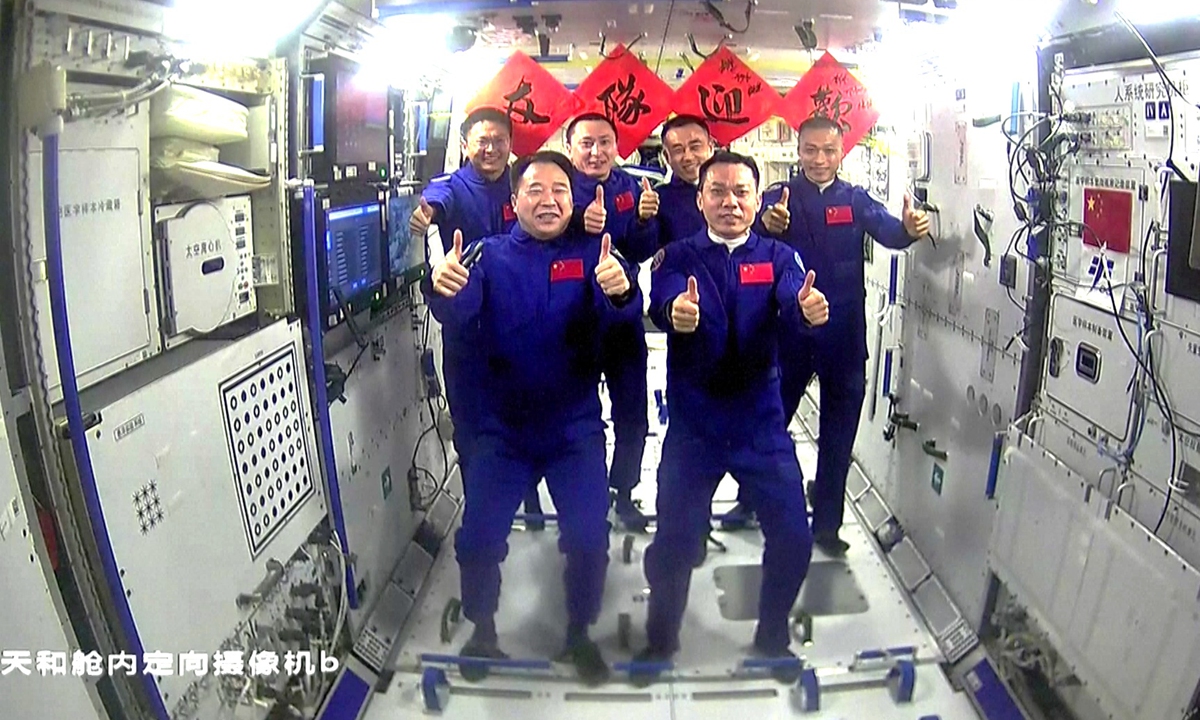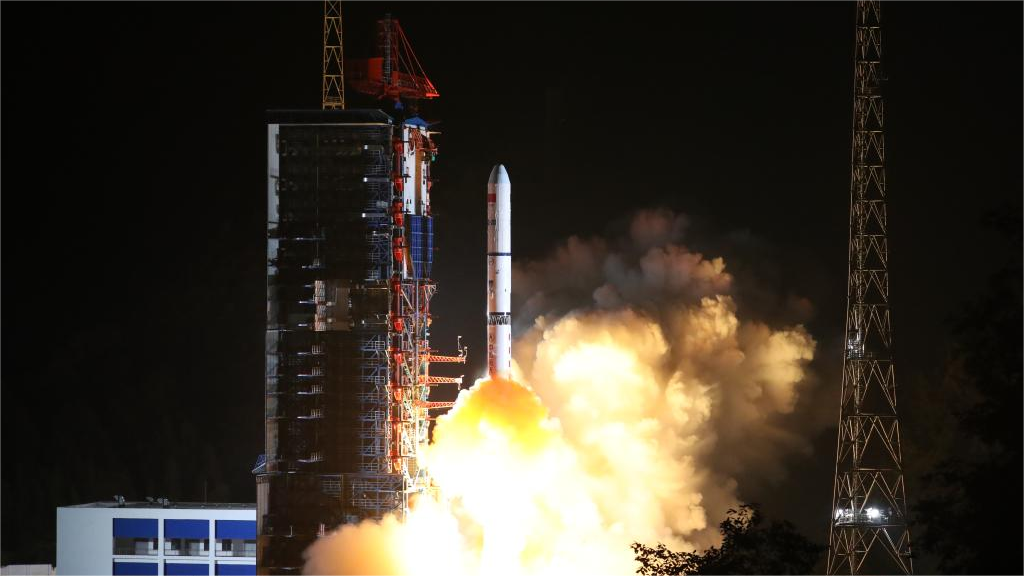Tiangong space station sees reunion of six taikonauts

Six Chinese taikonauts from two Shenzhou spaceflight mission crews pose at the Chinese space station, after three taikonauts aboard Shenzhou-17 spaceship entered the country's space station on October 26, 2023. The red sheets in the background read "Welcome teammates." Photo: CMSA
On the momentous occasion of the 20th anniversary of China's first manned spaceflight of the Shenzhou-5, China Space Station, also known as Tiangong, which means "heavenly palace", witnessed another historic moment in China's manned space history as six taikonauts from two Shenzhou spaceflight mission crews had their space reunion on Thursday afternoon, some 6.5 hours after the Shenzhou-17 spacecraft's successful lift-off on Thursday morning at around 11:14 am.
According to the China Manned Space Agency (CMSA), the Shenzhou-17 manned spacecraft successfully conducts rendezvous and docking with the Tianhe space station core module at the front port at 5:46 pm Thursday.
The Shenzhou-16 crew opened the door and welcomed the incoming Shenzhou-17 fellow taikonauts by 7:34 pm. The six then took a group picture to mark the historic reunion moment, according to the CMSA.
The two crew groups will carry out in-orbit rotation and work together in the China Space Station for around 4 days, the CMSA said.
Such a great feat of an in-orbit reunion of six taikonauts continues the new norm for the China Space Station with permanent occupation of taikonauts, mission insiders hailed, and they noted that the collaboration between the two crew groups will mark a significant step in China's ongoing space exploration endeavors, reinforcing its capability and commitment to long-term space habitation and research, they noted.
Sitting atop the Long March-2F Y17 carrier rocket, the spacecraft, carrying taikonauts Tang Hongbo, Tang Shengjie, and Jiang Linxin, embarked on the journey toward the China Space Station. Following a smooth flight of around 10 minutes, the Shenzhou-17 spacecraft entered its planned orbit, marking a successful launch, according to the official release by the CMSA.
With an average age of 39, the crew of taikonauts of the Shenzhou-17 mission is notably young, setting a record for China's manned space history.
Tang Hongbo, 48, will be the first second-generation taikonaut to lead two younger third-generation taikonauts on a Shenzhou mission. Tang will also be the first taikonaut to return to the Tiangong space station with the shortest interval between crewed spaceflight missions to date.
The Shenzhou-17 mission is the first space experience for both Tang Shengjie and Jiang Linxin.
Director of China Manned Space Engineering Office, and the country's first taikonaut Yang Liwei told the media that the third batch of taikonauts are undertaking special trainings for the China Space Station application and development phase and they will be honed to become the backbone of the future space endeavors.
The Shenzhou-16 crew, who spent five months working and living in orbit, is expected to return to Earth on October 31, according to their mission plan.
This year marks the 20th anniversary of China's first manned spaceflight mission the Shenzhou-5. In the past 20 years, China has carried out 12 crewed missions including the latest Shenzhou-17 mission, with a perfect success rate.
Also during this period, the mighty Long March-2F rocket and Shenzhou manned spacecraft at Jiuquan Satellite Launch Center have successfully launched 20 taikonauts, with 32 trips into space, holding aloft celestial dreams of the Chinese nation with a solid 100 percent success rate, the CMSA said in a statement it provided to the Global Times on Thursday.
Since its inaugural flight in 1999, the Long March 2F rocket, the country's first and only manned carrier rocket, has maintained a flawless record.
Through continuous efforts to address weak links and optimize technical conditions, the reliability assessment of Long March 2F rocket has now increased to 0.9896, with a safety assessment value reaching 0.99996. This showcases the rigorous enhancements and technical advancements that have been implemented to ensure the rocket's reliability and safety over the years, the rocket developer the state-owned China Academy of Launch Vehicle Technology (CALT) told the Global Times on Thursday.
Currently, the "one-launch-one-standby" launch process of the Long March 2F rocket has been compressed from 49 days during the initial construction phase of the space station to 35 days. Now, efforts are underway to further optimize and improve the process aiming for a 30-day target, to better meet the demands of the space station's application and development phase, developers said.
According to them, in the coming years, the Long March 2F rocket is set to continue its high-frequency launch schedule with two launches per year. It will play a crucial role in the operation of China's space station, demonstrating its pivotal role in supporting the country's ambitious space exploration and operation endeavors.
The Shenzhou-17 crewed flight mission, the 30th flight mission since the establishment of China's manned space program in 1992, has some crucial objectives.
The mission's primary goal includes completing the in-orbit crew rotation with the Shenzhou-16 trio, before they carry on to conduct an approximate six-month stay in space until April 2024.
During this period, the crew will engage in on-orbit trials of space science and application payloads, conduct extravehicular activities, commonly known as spacewalks, and perform payload extravehicular operations, which according to the CMSA, will also involve the installation of extravehicular payloads and maintenance tasks on the space station.
Moreover, the mission will continually evaluate the functional performance of the space station assembly, accumulating precious data and experience regarding space station operations. This initiative aims to assess the coordination and compatibility of the ground support center in managing space station operational tasks, thereby enriching the operational efficiency and troubleshooting capabilities of the space station, the CMSA said.
A significant highlight of the Shenzhou-17 mission is the pioneering experimental extravehicular repair operations to be undertaken on the space station, which will be a historic first.
Also, the Shenzhou-17 mission will carry a significant "Space Protein Molecular Assembly and Application Research" project, the Global Times learned from the space application system personnel on Thursday.
Aiming to advance humanity's health, the project encompasses 29 samples across five categories: proteins, polypeptides, nucleic acids, biological materials, and pharmaceutical materials. Samples include insulin, cancer treatment protein complexes, nano-hydroxyapatite/collagen polypeptide, and lysozyme, which were transferred to the launch tower about eight hours before launch, and placed inside the Shenzhou spacecraft to be launched into space, Cang Huaixing, a research fellow with the Center for Space Application Engineering and Technology, under the Chinese Academy of Sciences, told the Global Times.
China's steadfast progress in its manned space program, characterized by a strong emphasis on independence and prioritizing safety, indeed offers insightful lessons for emerging space powers like India. The meticulously structured steps, coupled with a robust support framework, pave the way for accomplishing complex space objectives, Song Zhongping, a space affairs watcher and TV commentator, told the Global Times on Thursday.
For India, which is in the early stages of its manned space journey, the roadmap towards establishing a notable presence in space is beginning to take shape. India's ambitious Gaganyaan mission marks a significant step towards reaching its manned space aspirations. The country conducted a crucial unmanned test of the emergency-escape system of its new crew capsule this mission on October 21, moving closer to its goal of launching its first manned mission in 2024.
Photos
Related Stories
- Launch history of manned missions to space by Long March-2F carrier rockets
- Highlights of Shenzhou-17 Mission
- See-off ceremony held for Shenzhou-17 crew
- 12th crewed mission to focus on space debris
- Scientists call for deeper international space science cooperation
- China, S. Africa space ties promise wide scope
- China to livestream 4th class from space station
- 10 paintings from Africa on display at Tiangong
- Cargo spacecraft burns up as planned on Earth reentry
- Shenzhou XVI crew completes 1st spacewalk
Copyright © 2023 People's Daily Online. All Rights Reserved.









